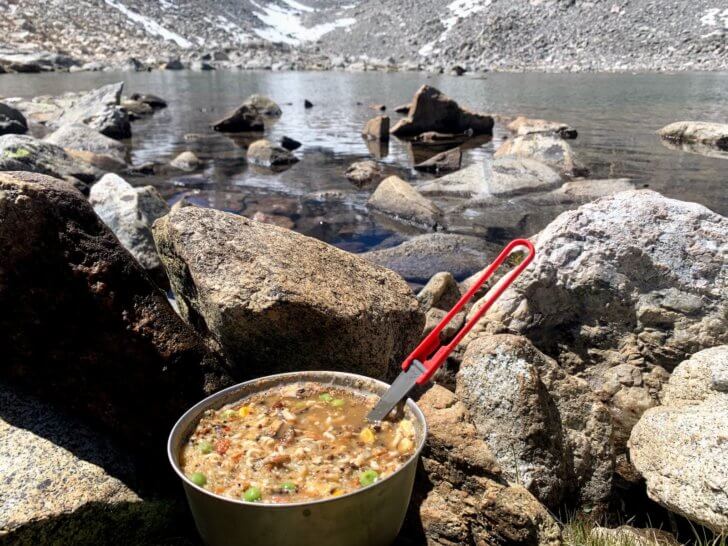
Answering the question:
How much food do I bring on my backpacking trip?
requires some consideration of a basic energy balance equation we can write as:
Calories of Energy Expended = Calories of Food Eaten + Calories of Body Fat Consumed
Since Calories of Food Eaten is what we’re really after, then we can rewrite the equation as:
Calories of Food Eaten = Calories of Energy Expended – Calories of Body Fat Consumed
–
Of course, the usual disclaimer applies: physiology and metabolism are far more complex than this. This equation is merely one attempt to simplify the process and capture the major components of energetics so we can (as a starting point) estimate how much food to pack on a trip. This equation represents a highly reliable, time-tested approach that I’ve been using (and validating) for more than 30 years. Of course, YMMV.
–
In fine ultralight style, assuming we want to exit at the trailhead with no excess food, we’re hoping that
Calories of Food Packed – Calories of Food Eaten = 0
Thus, I’d like to have a reasonable answer to the two questions:
- How many Calories of energy will I expend on my trek?
- How many Calories of body fat will I consume on my trek?
To answer the first question, I start with an empirical formula based on Petzoldt’s energy mile theory and derived from respiration studies:
Energy Miles = Actual Miles + N x Elevation Gain (ft) / 1000
where N is the energy cost of climbing. N generally varies between the values of about 1.3 and 2.0 and is dependent on pack weight, steepness of the grade, terrain difficulty, gender, state of fitness, and other factors.
In the study referenced above, subjects expended an average of 180-231 Calories per mile on a flat grade, and an average of 328-426 Calories per mile on a 9.5% grade. The resulting data analysis then suggests that N works out to be about 1.6.
Let’s apply this and see how it works out.
As a case study, we’ll take a look at the John Muir Trail, which is 211 miles in length and gains 47,000 feet in elevation. First, let’s calculate the number of equivalent energy miles:
211 Actual Miles + 1.6 x 47,000 ft / 1000 = 286 Energy Miles
Now, assume that you’re carrying a light pack (20 pounds) and the energy cost of carrying that pack on a flat mile (one energy mile) is about 200 Calories, then we can calculate the total Caloric requirements as
Energy Required for Hiking: 286 Energy Miles x 200 Calories per Energy Mile = 57,200 Calories
Add to this your basal caloric needs (for me that amounts to about 1,600 Calories per day) and determine the number of days on the trail (for example, hiking 15 miles per day would allow you to complete the JMT in 14 days):
Energy Required for Basal Metabolism: 15 days x 1,600 Calories per day = 24,000 Calories
If the average caloric density of your food is about 120 Calories per ounce, then we can calculate the total food weight required as:
( 57,200 + 24,000 = 81,200 Cal ) / 120 Cal per oz = 677 oz (42.2 pounds)
This works out to about 5,400 Calories per day or 45 oz (2.8 lb) of food per day! That’s a lot to carry!
Saving Food Weight: Lightweight Practices and Principles
1. Maximize Caloric density of foods
The example above assumes a caloric density of 120 Calories per ounce. To put this in context, consider the caloric density of the following ingredients that I have in my breakfast cereal:
- cereal grains – 100 Cal/oz
- freeze-dried berries – 110 Cal/oz
- seeds – 180 Cal/oz
- coconut chips – 200 Cal/oz
When I first started eating this cereal the recipe had a fairly low caloric density. I’ve since boosted it by playing with ingredient ratios, and adding coconut flakes.
The following table shows my before and after recipes.
Member Exclusive
A Premium or Unlimited Membership* is required to view the rest of this article.
* A Basic Membership is required to view Member Q&A events




Home › Forums › How Much Food Should I Pack? (How to save weight on backpacking food based on the energy-mile theory)